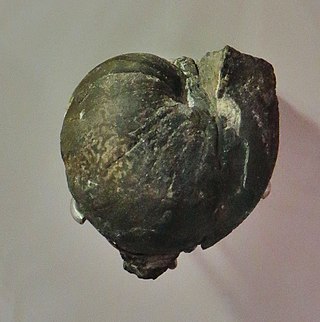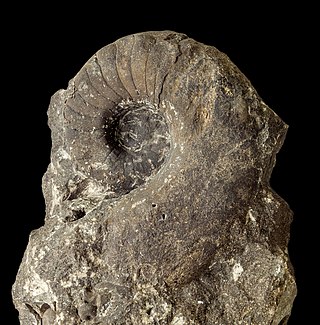
Trocholites is a tarphycerid genus in the family Trocholitidae from the Middle and Late Ordovician with a gradually expanding, weakly ribbed shell; whorls in contact, dorsum slightly impressed; cross section depressed, venter and sides rounded; siphuncle close to but not at the dorsal margin.
The Tarphyceratidae are tightly coiled, evolute Tarphycerida with ventral siphuncles. The dorsum is characteristically impressed where the whorl presses against the venter of the previous. The Tarphyceratidae are derived from Bassleroceras or possibly from some member of the Estonioceratidae.
Sholakoceras is an extinct genus of nautiloid cephalopods from the Lower Permian of southern Russia, included in the Tainoceratacean family Rhiphaeoceratidae,. The shell of Shalakoceras is evolute with a perforate umbilicus. Whorl sections are subquadrate with the ventral and lateral sides flattened and ventral and umbilical shoulders rounded. Lateral areas bear short, slightly oblique ribs. sutures form broad ventral saddles with a slight, shallow lobe, very shallow lateral lobes, and a deep funnel-shaped dorsal lobe.
Endolobus is an extinct genus from the nautiloid order, Nautilida. Nautiloids are a subclass of shelled cephalopods that were once diverse and numerous but are now represented by only a handful of species, including Nautilus. Endolubus is included in the family Koninckioceratidae which is part of the superfamily Tainoceratoidea.

The Trigonoceratoidea are a superfamily within the Nautilida that ranged from the Devonian to the Triassic, thought to have contained the source for the Nautilaceae in which Nautilus is found.
Syringonautilidae is a family of Nautiloidea from the middle to late Triassic. Syringonautilidae comprise the last of the Trigonoceratoidea and are the source for the Nautilaceae which continued the Nautiloidea through the Mesozoic and into the Cenozoic right down to the recent. Syringonautilidae is a strictly Triassic family, derived early in the Triassic from the Grypoceratidae.

Grypoceratidae is the longest-lived family of the Trigonoceratoidea, or of the near equivalent Centroceratina; members of the Nautilida from the Upper Paleozoic and Triassic.
The Centroceratidae is the ancestral family of the Trigonoceratoidea and of the equivalent Centroceratina; extinct shelled cephalopods belonging to the order Nautilida
The Naedyceras group comprises three similar and closely related openly coiled, gyroconic, genera within oncocerid family, Brevicoceratidae: Naedyceras, Gonionaedyceras, and Gyronaedyceras.
Aphelaeceras is an extinct genus from the nautilid family Trigonoceratidae which is part of the Trigonocerataceae, that lived during the Mississippian Period in the late Paleozoic.
Condraoceras is a genus of liroceratids from the Pennsylvanian of North America and Lower Permian of Europe with a compressed, involute, nautiliconic shell; subcircular whorl section; small umbilicus with a rounded shoulder; suture with shallow ventral and lateral lobes; and narrow subcentral siphuncle.

Peripetoceras is a genus in the Clydonautilacean family, Liroceratidae. It can be recognized by its smooth, involute shell with a deep small umbilicus with rounded shoulders and steep convex wall; whorl section with flattened venter, rounded ventral shoulders and convergent slightly convex flanks; suture with slight ventral and lateral lobes; and small siphuncle located dorsally of the center.
Thuringionautilus is a genus of large, moderately involute, nautiloids from the nautilid family Tainoceratidae. The whorl section is subquadrate, flanks slightly convex, venter broad with a median furrow. Ventral shoulders, narrowly rounded to subangular; umbilical shoulders, broadly rounded. Longitudinal nodes slope diagonally backwards on the venter toward the furrow. Suture, slightly sinuous. Siphuncle, subdorsal.

Metacoceras is a nautilitoid cephalopod from the Upper Carboniferous (Pennsylvanian) and Permian, the shell of which is moderately evolute with a subquadrate whorl section, bearing nodes on the ventral or umbilical shoulders or both, but otherwise smooth. The siphuncle is small, subcentral and orthochoanitic. The suture has shallow ventral and lateral lobes but no dorsal or annular lobe.
Enoploceras is a Tainoceratid genus, a nautiloid cephalopod in the order Nautilida, known from Triassic sediments in Europe, India, Timor, and the state of Idaho.
The Rhiphaeoceratidae are a small family of nautilids included in the superfamily Tainoceratoidea that comprises four very similar genera. These genera are characterized by a perforate umbilicus and little more than a single evolute coil. Whorl sections are oval, subquadrate, or subtrapezoidal. Sutures bend forward on the outer rim, forming wide shallow ventral saddles and dip strongly to the rear on the inner rim, forming deep dorsal lobes.
Pseudonautilidae is a family of Jurassic and Lower Cretaceous nautilid cephalopods belonging to the same superfamily as modern Nautilus, Nautilaceae, but forming a different branch from the family Nautilidae. Pseudonautilids, together with other nautilids, were contemporary with the ammonoids, which comprise an entirely different set of shelled cephalopod stocks more closely related to octopus and squid.
The Tetragonoceratidae is a small family of nautilitids constituting a part of the superfamily Tainocerataceae in which shells are coiled with a generally quadrate whorl section. Coiling is either gyroconic or evoluute with a slight dorsal impression. Flanks diverge from the umbilical to the ventral shoulders so as to make the whorl sections widest close to the venter. Nodes made develop on the flanks and shoulders. The siphuncle is tubular, typically found near the venter. Sutures are with lateral lobes and may possess dorsal and ventral lobes as well.
Wellsoceras is a tetragonoceratid that starts off with an evolute shell in which whorls are in contact, but has a mature living chamber that diverges and becomes free. The whorl section is slightly wider than high and is faintly subquadrangular. Flanks are slightly convex and tend to converge very slightly toward the center. All shoulders are strongly rounded. The suture is straight ventrally or with a slight ventral lobe, well developed lateral lobes, and a broad, low dorsal saddle. The siphuncle is located half way between the center and the ventral margin.

Domatoceras is a nautiloid genus and member of the Grypoceratidae from the Pennsylvanian and Permian with a wide spread distribution.



